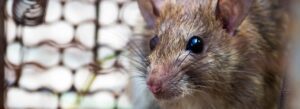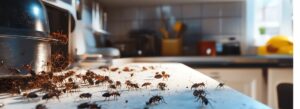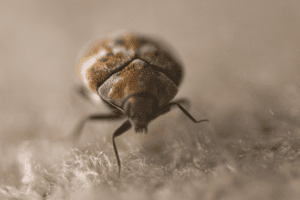A Kent-Focused Guide for Homes and Businesses in Ashford and Beyond
If you’ve ever looked out your window on a warm summer day and suddenly spotted hundreds of ants with wings crawling on the patio — or worse, flying through your kitchen — you’re not alone. Flying ants are a familiar summer sight in Kent, particularly in areas like Ashford, Canterbury, Maidstone, and the surrounding villages. But are they really a problem?
Let’s break it down for our local area.
What Are Flying Ants?
Flying ants are not a separate species. They’re simply the reproductive version of existing ant species — most commonly the black garden ant (Lasius niger). These flying forms are responsible for ensuring the reproduction and spread of the colony.
Only specific ants become winged: young queen ants and males. Their purpose is to take part in a nuptial flight where they mate, and new colonies are started. It’s a natural insect phenomenon, but in urban areas like Ashford, it often feels like an invasion.
Why Do Flying Ants Swarm All at Once?
When the temperature hits around 20°C and the humidity rises after a spell of rain, ant colonies across Kent coordinate a mass flight. Calm wind speeds are crucial for their take-off, and these conditions usually occur in July or August. It’s not a random event — it’s a survival strategy.
By taking to the skies in the thousands, flying ants reduce their risk of predation from birds and increase the chances of successful mating.
You may have seen news of this phenomenon picked up on weather radar systems — the swarms are so large they look like clouds of rain. Even the Royal Society of Biology has tracked these flights as part of their citizen science research into biodiversity and urban heat island effects.
Why Ashford and Kent See So Many?
Kent’s mix of urban areas, green spaces, and river valleys creates the perfect microclimates for ants to thrive. Ashford’s housing developments, for example, often have:
- Soil-rich flower beds close to structures
- Wooden fences and decking
- Raised temperatures due to hard surfaces (urban heat island effect)
This makes the region ideal for multiple ant species including:
- Black garden ant (Lasius niger)
- Pharaoh ant (found indoors)
- Myrmica rubra (the red ant)
- Carpenter ants (which nest in damp or decaying wood)
Each has slightly different behaviour, but all can cause issues during flying ant season.
Are Flying Ants Actually a Pest?
Yes — when they cross into human spaces. Here’s when flying ants go from being a natural event to a pest control issue:
- Swarms inside the house, especially in kitchens or lofts
- Repeated infestations year after year
- Signs of a nest inside cavity walls, insulation, or floorboards
- Ants emerging from damp wood, vents, or under skirting boards
Flying ants might not bite like a flea, sting like a wasp, or buzz like a bee, but they can:
- Contaminate food and surfaces
- Disturb family life or business operations
- Attract other insect predators
- Contribute to building damage if nesting internally
Some ants — like the carpenter ant — prefer decaying wood, and can cause slow, hidden damage to joists and frames. They’re not as aggressive as a hornet or wasp, but long-term infestation poses a real risk.
What About the Environment?
Flying ants are part of the UK’s broader ecosystem. They help aerate soil, recycle dead plant matter, and are food for birds, beetles, and wildlife. Some even aid in flower pollination — like a butterfly or bee — though less efficiently.
That said, their contribution to biodiversity doesn’t mean you need to tolerate them in your home or workspace. Like cockroaches or bed bugs, their presence indoors is not normal.
The Royal Horticultural Society recommends managing pest populations in ways that preserve local wildlife but protect your personal environment. That’s where smart, localised pest control comes in.
Prevention Tips for Kent Homes and Businesses
Outside:
- Treat patio cracks and borders in early spring
- Avoid excessive watering near walls (ants love moist soil)
- Prune back plants touching walls and windows
Inside:
- Seal gaps and cracks around doors, windows, and pipes
- Use insect repellent sprays containing essential oils like peppermint, tea tree, or clove
- Store food in airtight containers
- Check lofts, basements, and under floorboards for signs of nesting
Carpenter ants, pharaoh ants, and others may target different materials — from damp wood to food spills or soft liquid residues — especially in kitchens and bin areas.
When Should You Call in Innovation Pest Control?
If you:
- See swarms emerging from indoor walls or flooring
- Deal with ants every summer
- Run a business and need to maintain hygiene ratings
Then DIY solutions just won’t cut it.
Innovation Pest Control specialises in:
- Locating hidden ant colonies
- Identifying invasive species like pharaoh or carpenter ants
- Discreet, same-day pest control across Kent
- Long-term solutions that are safe for homes, pets, and plants
📞 Call us today on 07743 958655 📧 Or email us to book a survey
Final Thoughts
Flying ants aren’t aggressive. But that doesn’t mean they’re harmless — especially if they’re swarming inside your property or nesting in damp timber. Whether it’s a black garden ant, carpenter ant, or something else, they all point to one thing: a growing ant problem.
With Kent’s heat, humidity, and unpredictable weather, flying ant phenomena are here to stay — especially in urban hotspots like Ashford and Canterbury.
But you don’t have to tolerate them. Innovation Pest Control is local, expert, and fast. We handle ants, fleas, bed bugs, beetles, and more.
📞 Call 07743 958655 to protect your property.
Let us handle the pests — so you can enjoy your home, business, and summer without the swarms.






